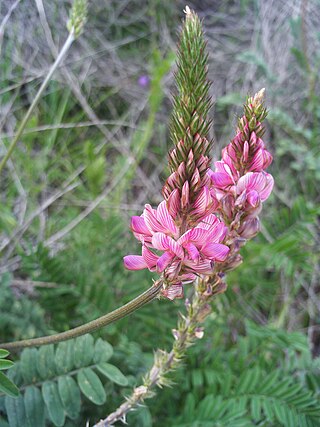
Onobrychis viciifolia, also known as O. sativa or common sainfoin has been an important forage legume in temperate regions until the 1950s. During the Green Revolution it was replaced by high yielding alfalfa and clover species. Due to its anthelmintic properties the common sainfoin is a natural alternative to drugs to control nematode parasitism in the guts of small ruminants. This is the main reason why O. viciifolia came back to the scientific agenda during the last years.
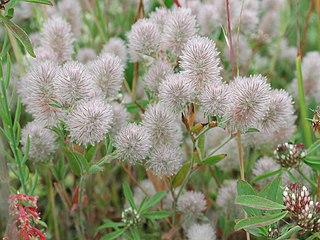
Trifolium arvense, commonly known as the hare's-foot clover, rabbitfoot clover, stone clover or oldfield clover, is a flowering plant in the bean family Fabaceae. This species of clover is native to most of Europe, excluding the Arctic zone, and western Asia, in plain or mid-mountain habitats up to 1,600 metres (5,200 ft) altitude. It grows in dry sandy soils, both acidic and alkaline, soil with dry-mesic conditions and is typically found at the edge of fields, in wastelands, at the side of roads, on sand dunes, and opportunistically in vineyards and orchards when they are not irrigated.

Melilotus officinalis, known as sweet yellow clover, yellow melilot, ribbed melilot and common melilot, is a species of legume native to Eurasia and introduced in North America, Africa, and Australia.

Melilotus albus, known as honey clover, white melilot (UK), Bokhara clover (Australia), white sweetclover (US), and sweet clover, is a nitrogen-fixing legume in the family Fabaceae. Melilotus albus is considered a valuable honey plant and source of nectar and is often grown for forage. Its characteristic sweet odor, intensified by drying, is derived from coumarin.
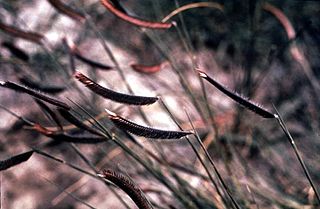
Bouteloua gracilis, the blue grama, is a long-lived, warm-season (C4) perennial grass, native to North America.

Revegetation is the process of replanting and rebuilding the soil of disturbed land. This may be a natural process produced by plant colonization and succession, manmade rewilding projects, accelerated process designed to repair damage to a landscape due to wildfire, mining, flood, or other cause. Originally the process was simply one of applying seed and fertilizer to disturbed lands, usually grasses or clover. The fibrous root network of grasses is useful for short-term erosion control, particularly on sloping ground. Establishing long-term plant communities requires forethought as to appropriate species for the climate, size of stock required, and impact of replanted vegetation on local fauna. The motivations behind revegetation are diverse, answering needs that are both technical and aesthetic, but it is usually erosion prevention that is the primary reason. Revegetation helps prevent soil erosion, enhances the ability of the soil to absorb more water in significant rain events, and in conjunction reduces turbidity dramatically in adjoining bodies of water. Revegetation also aids protection of engineered grades and other earthworks.

Agropyron cristatum, the crested wheat grass, crested wheatgrass, fairway crested wheat grass, is a species in the family Poaceae. This plant is often used as forage and erosion control. It is well known as a widespread introduced species on the prairies of the United States and Canada.
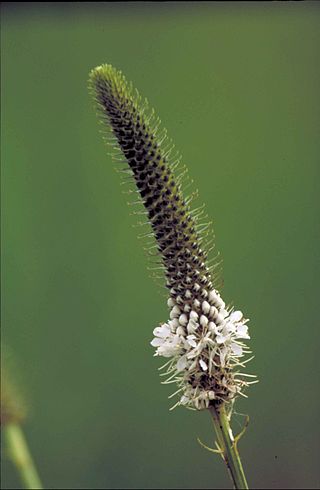
Dalea is a genus of flowering plants in the legume family, Fabaceae. Members of the genus are commonly known as prairie clover or indigo bush. Its name honors English apothecary Samuel Dale (1659–1739). They are native to the Western hemisphere, where they are distributed from Canada to Argentina. Nearly half of the known species are endemic to Mexico. Two species of Dalea have been considered for rangeland restoration.

Marina is a genus in the legume family, Fabaceae. It includes 40 species native to southern North America, ranging from California and New Mexico through Mexico and Central America to Costa Rica. They are known as the false prairie clovers. Unlike the related prairie clovers, which bear two ovules per fruit, false prairie clovers bear only one ovule per fruit.

Dalea mollissima is a desert wildflower plant in the legume family (Fabaceae), with the common names soft prairie clover, downy dalea, and silk dalea.

Dalea foliosa, commonly called leafy prairie clover, is a species of flowering plant in the legume family (Fabaceae). It is an endangered species in the United States, where it occurs in three states: Illinois, Tennessee, and Alabama.

Dalea candida is a species of flowering plant in the legume family known by the common name white prairie clover. It is native to North America, where it can be found throughout central Canada, the central United States, and northern Mexico. It can sometimes be found outside its range as an introduced species. It grows in many types of habitat, including several types of prairie, foothills, woods, forests, and disturbed areas.
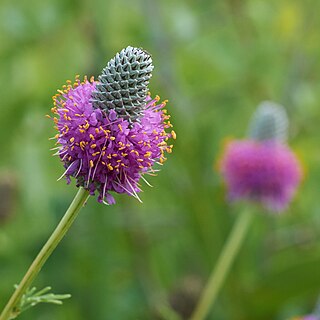
Dalea purpurea is a species of flowering plant in the legume family known as purple prairie clover. Native to central North America, purple prairie clover is a relatively common member of the Great Plains and prairie ecosystems. It blooms in the summer with dense spikes of bright purple flowers that attract many species of insects.

Elymus lanceolatus is a species of grass known by the common names thickspike wheatgrass and streamside wheatgrass. It is native to North America, where it is widespread and abundant in much of Canada and the western and central United States. There are two subspecies, subsp. lanceolatus occurring throughout the species' range and subsp. psammophilus occurring in the Great Lakes region.
Dalea carthagenensis is a species of flowering plant in the legume family known by the common name Cartagena prairie-clover. It is native to the Americas, where it is found in South America, Central America, the West Indies, and the US state of Florida.
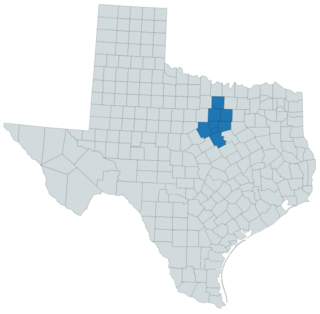
Dalea reverchonii is a species of flowering plant in the legume family known by the common name Comanche Peak prairie-clover. It is endemic to Texas in the United States, where it is known from Bosque, Erath, Hood, Johnson, Parker, Somervell, Tarrant, and Wise counties. This species was first collected by Julien Reverchon at the top of Comanche Peak. As of 2015 the species still grows there.

Hedysarum boreale is a species of flowering plant in the Fabaceae, or legume family, and is known by the common names Utah sweetvetch, boreal sweet-vetch, northern sweetvetch, and plains sweet-broom. It is native to North America, where it is widespread in northern and western regions of Canada and the United States. The ssp. mackenzii can even be found in the Canadian Arctic Archipelago.
Astragalus anisus is a species of flowering plant in the legume family known by the common name Gunnison milkvetch. It is endemic to Colorado in the United States, where it is limited to the Gunnison Basin of Gunnison and Saguache Counties.

Dalea multiflora, commonly called roundhead prairie clover, is a species of flowering plant in the legume family (Fabaceae). It is native to North America, where it is found in Mexico and the United States. In the U.S., it is primarily found in the Great Plains and South Central regions. Its natural habitat is in dry rocky prairies, particularly in limestone soils. It is a conservative species and can be indicative of undisturbed prairie communities.

Fanny Searls, also known by her married name Fanny Gradle, was an American physician and botanical collector. Dalea searlsiae, Searls' prairie clover, is named after her. Born in Waukegan, Illinois, she attended Northwestern University and the University of Michigan, gaining her medical degree in 1877. She then worked at Bellevue Hospital as a student nurse as there were few opportunities for women to gain medical internships at the time. In the meantime, she had developed skills as a concert pianist and a collector of botanical and geological specimens. In the last capacity, she donated a collection of 215 specimens gathered in Nevada to Northwestern University, including the first subsequently named Searls' prairie clover. She moved to Santa Barbara, dying there in 1939.



















